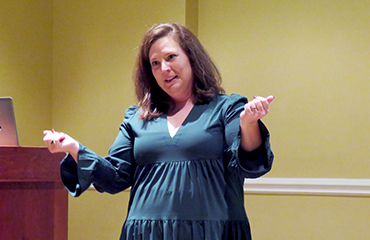 Fairy tales have remained popular through the ages because “they ignite the imagination, and they reveal human nature.”
Fairy tales have remained popular through the ages because “they ignite the imagination, and they reveal human nature.”
That was a takeaway of Lander University Senior Lecturer of English Brittany Cuenin’s analysis of the genre at Greenwood’s Arts Center on Wednesday, Nov. 15.
Cuenin, the final speaker of the year in Lander’s Community Lecture Series, said that fairy tales usually depict a struggle between good and “pure, unadulterated evil.” As an example, she cited “Hansel and Gretel,” who fall into the hands of a witch who likes to eat children.
In fairy tales, according to Cuenin, actions have consequences. The witch is burned to a crisp in the oven she has prepared for Hansel. Cinderella’s stepsisters are punished for their mistreatment of her by having their eyes pecked out, in the Grimm Brothers’ version of the story.
The form of a fairy tale, and the elements of which it is composed, are products of the culture from which it came, she said, describing the typical fairy tale as a “stew.”
Fairy tales are often more complex than they appear. For instance, there is “a lot of sexual innuendo” in “Little Red Riding Hood.” The point of the story is usually thought to be “don’t talk to strangers,” but Cuenin thinks that the French aristocrat Charles Perrault, who included it in his book, “Tales of Mother Goose,” was also warning readers to “watch out for charming men,” who might be wolves in disguise.
Like many Americans, Cuenin was introduced to fairy tales through Disney adaptations of them, but she has since been more interested in what she calls “literary fairy tales,” which are “about more than the knight in shining armor coming to save the helpless heroine.”
In many literary fairy tales, she said, the heroine is not helpless at all. “She’s intelligent. She tends to overcome situations.”
Cuenin, who teaches courses on fairy tales, attributes their enduring popularity to the truths they tell about the human condition. Her students have little trouble connecting with a tale like “Beauty and the Beast,” she said, although it was first written down more than 250 years ago.
It’s about “love, and how do you love someone? Isn’t it crazy how relevant it is?” she said.
Cuenin believes that the time she has spent researching fairy tales was time well spent. She encouraged audience members to “read them on your own.”